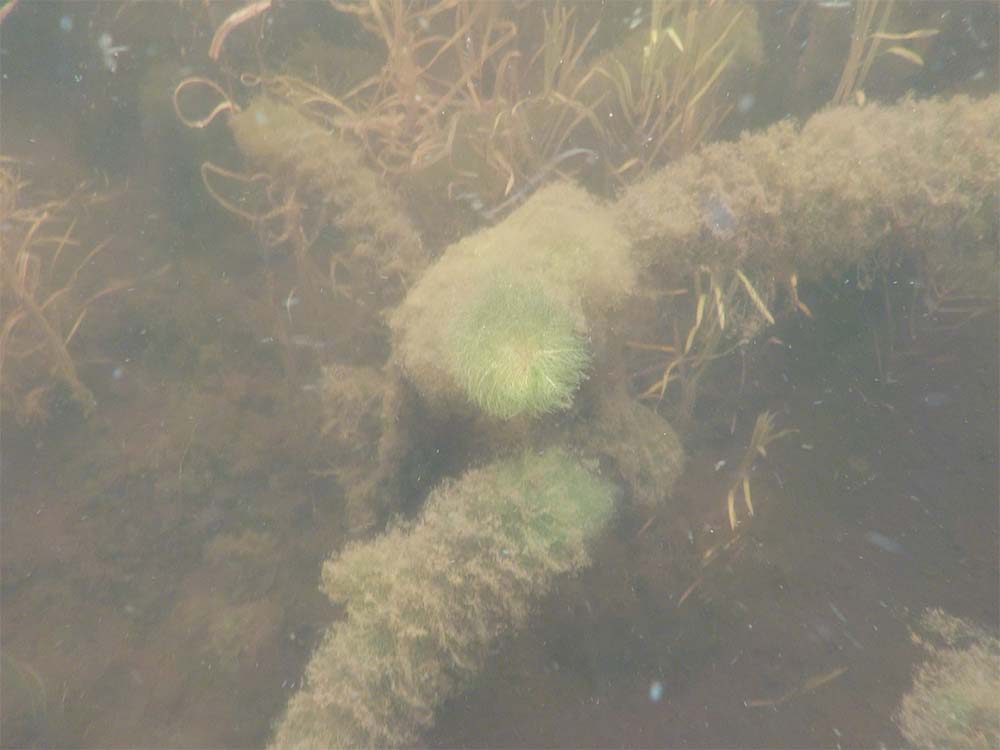 By Angela Pagano, associate professor, biological sciences
By Angela Pagano, associate professor, biological sciences
There is forest beneath the surface of the lake. Stands of pondweeds, free-floating bladderworts, and short-statured isoetids occupy the water column as far as light can penetrate. Water lilies float atop the shallows, and the stiff, bayonet-like blades of rushes seem to guard the entrance to this underwater realm. The freshwater forest is a key component of the lake ecosystem, providing habitat for fish and a diversity of invertebrates, stabilizing sediment and improving water clarity, and playing an important role in nutrient cycling within the lake.
But the underwater wilderness of Raquette Lake is changing. Dense mats of variable-leaf milfoil (Myriophyllum heterophyllum) have become a common part of the landscape. Under water, these plants resemble a bottle brush, with whorls of feather-like leaves arranged along stems that reach 1-4 meters in length. Masses of these tangled stems cut off light to other plants, reduce oxygen availability for fish and can decrease sediment quality. Variable-leaf milfoil can also negatively impact lake recreation, as stems get twisted onto boat motors and impede swimming and fishing.
 Although native to the United States, variable-leaf milfoil’s range was historically restricted to the southeastern part of the country. The plant is believed to have been introduced into Connecticut in the 1930s and has since spread throughout the Northeast, becoming a nuisance aquatic plant in its new range. A perennial, variable-leaf milfoil’s common name comes from the presence of two leaf types on the plant — a narrow, oval shaped, stiff emergent form and the feathery submersed form. Variable-leaf milfoil can reproduce sexually, producing small reddish flowers on the emergent stalks, as well as through fragmentation of its stem. This latter characteristic is thought to have contributed to the plant’s rapid spread as fragments are easily transported and can survive out of water for hours.
Although native to the United States, variable-leaf milfoil’s range was historically restricted to the southeastern part of the country. The plant is believed to have been introduced into Connecticut in the 1930s and has since spread throughout the Northeast, becoming a nuisance aquatic plant in its new range. A perennial, variable-leaf milfoil’s common name comes from the presence of two leaf types on the plant — a narrow, oval shaped, stiff emergent form and the feathery submersed form. Variable-leaf milfoil can reproduce sexually, producing small reddish flowers on the emergent stalks, as well as through fragmentation of its stem. This latter characteristic is thought to have contributed to the plant’s rapid spread as fragments are easily transported and can survive out of water for hours.
Efforts are underway to reduce the impact of variable-leaf milfoil in Raquette Lake. Stewards posted at the town boat launch help inspect incoming boats and trailers for fragments that may be stuck to hulls and motors. Populations of variable-leaf milfoil already established in the lake are being managed through the use of benthic barriers, akin to weed cloth used to control plant growth on land, and hand harvesting. To help with these efforts, anyone involved in activities on the lake should be aware of the potential to spread this invasive plant. Be sure to clean boats and any equipment used in the lake of plant fragments and dispose of them away from the water. The actions of all of us that enjoy Raquette Lake can make a difference.
Reference: Crow, G. E. and C. B. Hellquist. 2000. Aquatic and wetland plants
of Northeastern North America. Volume 1. The University of Wisconsin
Press, Madison, Wisconsin.